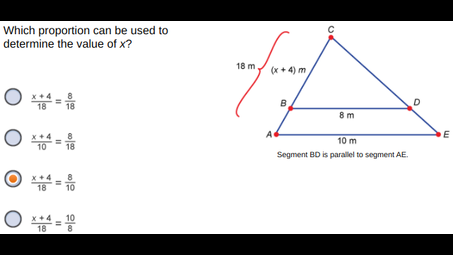What else can I help you with?
Can proportion be nagative value?
No. A proportion is the relationship of one part of something to the whole thing. If X is a fifth of Y, this must be a positive value.
What is a direct proportion?
Two quantities x and y are said to be in direct proportion if whenever the value of x increase (or decrease), then the value of y increases (or decrease) in such a way that the ratio x/y remains constant.
What is the value of x plus y?
The value of x + y is indeterminate. You need the values of both x and y to determine x + y.
What is the constant of proportionality in math?
If two variables, X and Y, are in direct proportion then Y = c*X for some fixed value c. This value, c, is the constant of proportionality for this relationship.
How To Solve A Proportion?
To solve a proportion, you cross multiply. For example, if this was the proportion: 2/4 = 3/x, you would multiply 2 with x and 4 with 3. The products will be used in your next equation. In this case, your next equation is 2x = 12. Now you want to isolate x, so divide by two for both sides. Your answer will be x = 6.
What value of x will make this proportion true?
To determine the value of x that makes the proportion true, you need to set up the equation based on the given proportion. For example, if the proportion is a/b = c/d, you can cross-multiply to get ad = bc. Then, solve for x by isolating it on one side of the equation. If you provide the specific proportion, I can help you find the value of x.
Can proportion be nagative value?
No. A proportion is the relationship of one part of something to the whole thing. If X is a fifth of Y, this must be a positive value.
Why is x 6 a solution to the proportion?
To determine why ( x = 6 ) is a solution to a proportion, we need to check if it satisfies the equality established by the proportion. A proportion typically takes the form ( \frac{a}{b} = \frac{c}{d} ). If substituting ( x = 6 ) into the proportion results in both sides being equal, then ( x = 6 ) is indeed a valid solution.
What is a direct proportion?
Two quantities x and y are said to be in direct proportion if whenever the value of x increase (or decrease), then the value of y increases (or decrease) in such a way that the ratio x/y remains constant.
How do you find the missing value of a proportions?
To find the missing value in a proportion, you can set up a ratio equation based on the known values. For example, if you have the proportion ( \frac{a}{b} = \frac{c}{x} ), you can cross-multiply to get ( a \cdot x = b \cdot c ). Then, solve for the missing value ( x ) by rearranging the equation to ( x = \frac{b \cdot c}{a} ). This method allows you to find the unknown value using the relationships established by the proportion.
What value of x will make this proportion true 3-29 x-116?
To find the value of ( x ) that makes the proportion ( \frac{3}{29} = \frac{x}{116} ) true, you can cross-multiply. This gives you ( 3 \times 116 = 29 \times x ), or ( 348 = 29x ). Dividing both sides by 29, you get ( x = \frac{348}{29} ), which simplifies to ( x = 12 ). Thus, the value of ( x ) is 12.
What is 10 percent of 86?
Set up a proportion. 10/86 = x/100. I used 100 because all percentages are out of 100%. Cross multiply and solve for the value of x.
How do you determine direct and inverse proportion on graphs?
If the variables x and y are in direct proportion then the graph of y against x is a straight line through the origin. If the variables x and y are in inverse proportion then the graph of y against x is a rectangular hyperbola. Alternatively, the graph of y against 1/x (or 1/y against x) is a straight line through the origin.
How are proportions related to direct variations?
If two variable, X and Y are in direct variation, then the proportion of X/Y or Y/X has a constant value.
If 3 8 6 x then tha value of x?
Not enough information has been given to determine the value of x
Why is x 4 a solution to the proportion x 5616?
To determine why ( x = 4 ) is a solution to the proportion ( \frac{x}{5616} ), we can substitute ( x ) with 4 in the equation. This gives us ( \frac{4}{5616} ), which simplifies to ( \frac{1}{1404} ). If the proportion is set equal to another fraction that also simplifies to ( \frac{1}{1404} ), then ( x = 4 ) is indeed a valid solution. Without the complete proportion, this explanation assumes that ( \frac{x}{5616} ) equals ( \frac{1}{1404} ).
What is the value of x plus y?
The value of x + y is indeterminate. You need the values of both x and y to determine x + y.

